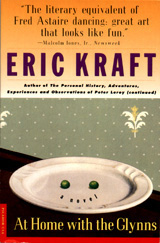
YOU CAN READ
THE FIRST HALF OF
THE BOOK
(21 CHAPTERS)
HERE,
ONLINE,
OR,
FOR MAXIMUM PORTABILITY
AND CONVENIENCE
WHEN READING
ON THE BEACH
OR
IN THE TUB,
YOU CAN BUY THE
PICADOR USA
PAPERBACK EDITION AT
AMAZON.COM
OR
BARNES&NOBLE.COM
OR
YOU CAN DOWNLOAD
THE COMPLETE TEXT
AS AN
eBOOK
AND
READ IT ON A PDA.

|
Chapter 5
The Acquisition of a Potentially Useful Skill
 ACK
IN MY ROOM AGAIN, I hit on the idea of practicing with marbles instead
of peas. I was a little beyond the age of playing with marbles.
Among the other kids my age at school, marbles were no longer in favor.
A few still played with them, but when I saw that those who did were bespectacled,
small, runny-nosed, and disdained, I put my marbles away. I took
them out now and then, in private, just to appreciate them as beautiful
objects, but simply looking at them was never entirely enough appreciation.
They were meant to be played with, not merely admired. ACK
IN MY ROOM AGAIN, I hit on the idea of practicing with marbles instead
of peas. I was a little beyond the age of playing with marbles.
Among the other kids my age at school, marbles were no longer in favor.
A few still played with them, but when I saw that those who did were bespectacled,
small, runny-nosed, and disdained, I put my marbles away. I took
them out now and then, in private, just to appreciate them as beautiful
objects, but simply looking at them was never entirely enough appreciation.
They were meant to be played with, not merely admired.
Luckily, I lived on a block with many younger children.
They looked up to me, and I encouraged it. They often came to my
house and asked my mother if I could play with them. Sometimes, under
the protective guise of teaching them, I played marbles with them.
I let them win my old marbles, the ones that were chipped and milky, and
thereby whittled my collection down to the best of the transparent marbles—the
clear, the tinted, the brilliant reds and greens—and the cat’s eyes—best
of the best, clear marbles with a twisted leaf of color in the center that
from certain angles resembled the pupil in the eye of a cat. These
dazzlers I protected with all my skill and effort, and because I always
won with these marbles, my students came to think of them as charmed, in
the manner—as I later came to learn—of so very many people who, confronted
with someone who has achieved something by dint of honest labor vigorously
and unstintingly applied, would rather think of it as unfairly won, the
product of an unfair advantage, like luck or talent or magic or divine
election.
I tried rolling a couple of cat’s eyes and found
them so much easier to work with than peas that I wondered why the Glynns
hadn’t thought of them. Possibly it was because marbles were not
as likely to come so readily to the mind of a girl as they did to the mind
of a boy, I thought, chuckling indulgently while I rolled the marbles upward
and back and read my social studies assignment at the same time.
I did well with the marbles, well enough that I thought I might be able
to get away with using marbles exclusively.
I began carrying a pair of marbles in my pocket.
These pocket marbles were not for practice, though. I was doing my
practicing at home. I carried the marbles so that I could show off.
At school, during homeroom or a study hall, I would take the marbles out
and begin rolling them with my eyes closed, hoping that someone would notice
this unusual behavior and ask me about it. I got quite good at manipulating
them, and, with an uncanny prescience that startles me even now, thirty-six
years later, began to develop a repertory of manipulations, from touching
them, feeling them, fingering them, handling them (all maneuvers that were
harder than they sound, since the marbles had a lively reluctance to stay
put while they were touched, felt, fingered, or handled), to more active
manipulations, such as grazing, brushing, caressing, fondling, pawing,
rubbing, stroking, and toying with the marbles, all in addition, of course,
to the rollings—up and back, side to side—that one would expect to find
in the bag of tricks of a marble manipulator. Often enough, I was
asked what the heck I was doing, often enough to get a taste of the satisfying
fame conferred for a distinguishing oddity and for the attainment of a
skill, and so I had the erroneous feeling that I was doing well.
That feeling was dispelled soon enough, one day when the Glynns again plunked
themselves down on either side of me in the cafeteria just as I was scraping
the raisin gravy off my ham slice.
“Hey,” said Margot, leaning close to me and whispering
into my ear, “what’s the idea with the marbles?”
“Oh,” said I, grinning with the pleasure of having
an asset discovered, as if I had been writing a poem in secret and had,
by accident or design, left some rejected pages of my work out on my worktable,
where they might be discovered, leading to their publication, to my passing
embarrassment and lasting fame, “the marbles.” I reached into my
pocket and pulled the marbles out. “I’ve been practicing. Let
me show you.”
“No thanks,” said Martha. She scooped up the
marbles with the swift movement of one who in her earlier days must have
been an accomplished player of jacks. “Your marbles days are over.”
“Or should be,” said Margot. “Marbles are
for kids.”
“Oh, sure,” I said, suddenly embarrassed.
“Sure. Of course. For kids. But they’re pretty challenging.”
“Come on, Peter,” said Martha.
“No, really,” I asserted. “They take some
skill. And they’re a lot less messy than peas. I can carry
them around in my pocket and practice at any time.”
“He’s got a point,” said Martha.
“Please, Martha,” said Margot. “That’s part
of the problem, Peter,” she added. “The way you keep taking them
out and practicing in front of everyone.”
“Practicing?” I said. “But I thought you wanted
me to practice.”
“At home, Peter,” said Margot. “In the privacy
of your little room. What you do there is practicing. But what
you’re doing with these marbles of yours isn’t practicing. It’s just—”
“—showing off,” said Martha.
“No, it’s not,” I claimed, as guilty parties do.
Martha gave me one of those looks of hers, with
those incredulous eyes, that disbelieving grin.
“We’re not ready to have the whole school know that
you’re honing your little skills, honey,” said Margot.
“Sorry,” I said with a shrug. “I didn’t realize—”
To my surprise, I felt myself begin to blush, because,
although I still had no idea what their intentions might be, what plans
they had for using me and my pea-poking skills, Margot and Martha had made
it clear that what I was doing was something that shouldn’t be seen, shouldn’t
be known, and at that time of life I had so many interests that had to
be kept out of sight that a blushing embarrassment and almost reflexive
stuffing of my hands into my pockets was my immediate response to the vaguest
threat of having any of them discovered. Let someone call to me “Hey,
Peter!” and the blush would spread over my face, my hands would fly into
my pockets, and I’d look at my shoes.
“Never mind,” said Margot. “Just knock it
off. Now let me see how you’re doing.” She picked a raisin
from the pool of viscid gravy on the side of my plate. Martha did
the same.
“Won’t everybody see?” I asked, concerned now as
I hadn’t been before.
“We’ll cover you,” said Martha, moving her milk
carton near my hand so that it would hide my raisin work from most of the
room. I had to chuckle about this misuse of cover, since I
was a devotee of the technical vocabulary of Westerns.
“You don’t mean ‘cover,’” I began. “Covering
is shooting at the bad guys—or it could be the good guys—any guys
who are shooting at you—or might shoot at you if they got
the chance—or not you, exactly, if you’re the one who’s doing the covering—but
might shoot at the guy you’re covering—”
“Never mind that,” said Margot, dismissing an entire
department of my little store of learning. “Palpate those raisins.”
“‘Palpate’?”
“Touch them. Roll them. Rub them,” said
Martha. “Get to work.”
Nervously now, with a childish foretaste of the
clammy fear known to anyone who has endured an oral examination or a job
interview, I rested a finger on each of the raisins.
“They’re sticky,” I said. “And kind of slippery,
too.”
The girls giggled.
“Lightly, now, Peter,” said Margot. “Side
to side.”
I could tell that I was in trouble right away.
The perfection of the marbles’ shape made their behavior predictable in
comparison to the raisins. The marbles also had, of course, the glassy
hardness marbles are known for, and the raisins, with their coating of
mucilaginous gravy, were slippery, unpredictable little devils, with a
resilience that was a little startling, as if there were some life in them
still. In working with the marbles, which had a tendency to skitter
on smooth surfaces, I had lost the light touch. I was being cautious
now, too cautious to display any of the skill that I thought I had acquired.
I wasn’t doing much of anything to the raisins, barely moving them.
“What’s this?” asked Martha. “You’re not doing
anything.”
“I am,” I said. “It’s just that, well, raisins
are kind of hard to work with.”
“Oh?”
“Yeah. They’re soft, and yet they kind of
push back at you, and they’re not round, not even as round as peas—”
“Mm-hmm.”
“Up and down, now, Peter,” said Margot.
“Up and down,” I said. “Okay.”
“See if you can kind of stroke the raisin instead
of making it roll like that.”
“No, I like that rolling,” said Martha.
“Okay, make hers roll,” said Margot, “but just stroke
mine.”
I did my best.
“What do you think?” asked Martha.
“Back to the peas,” said Margot. “You’re just
going to have to find a way to practice rolling peas, Peter.”
“But—” I began.
“Listen, Peter,” said Martha. “You know how
kids in class are always asking, ‘What good is this going to do me?’”
“Yeah,” I said. That was a frequent topic
of debate: whether the things we were learning would be at all useful to
us in “life,” when we were grown up, or even while we were still kids,
doing whatever we did all day.
“Well, I promise you, Peter, that this is going
to be useful,” she said.
“Okay,” I said. “I’ll take your word for it.”
“Good,” she said.
“Good,” said Margot. She ate a raisin and
giggled.
|

|



 Here
are a couple of swell ideas from Eric Kraft's vivacious publicist, Candi
Lee Manning:
Here
are a couple of swell ideas from Eric Kraft's vivacious publicist, Candi
Lee Manning: